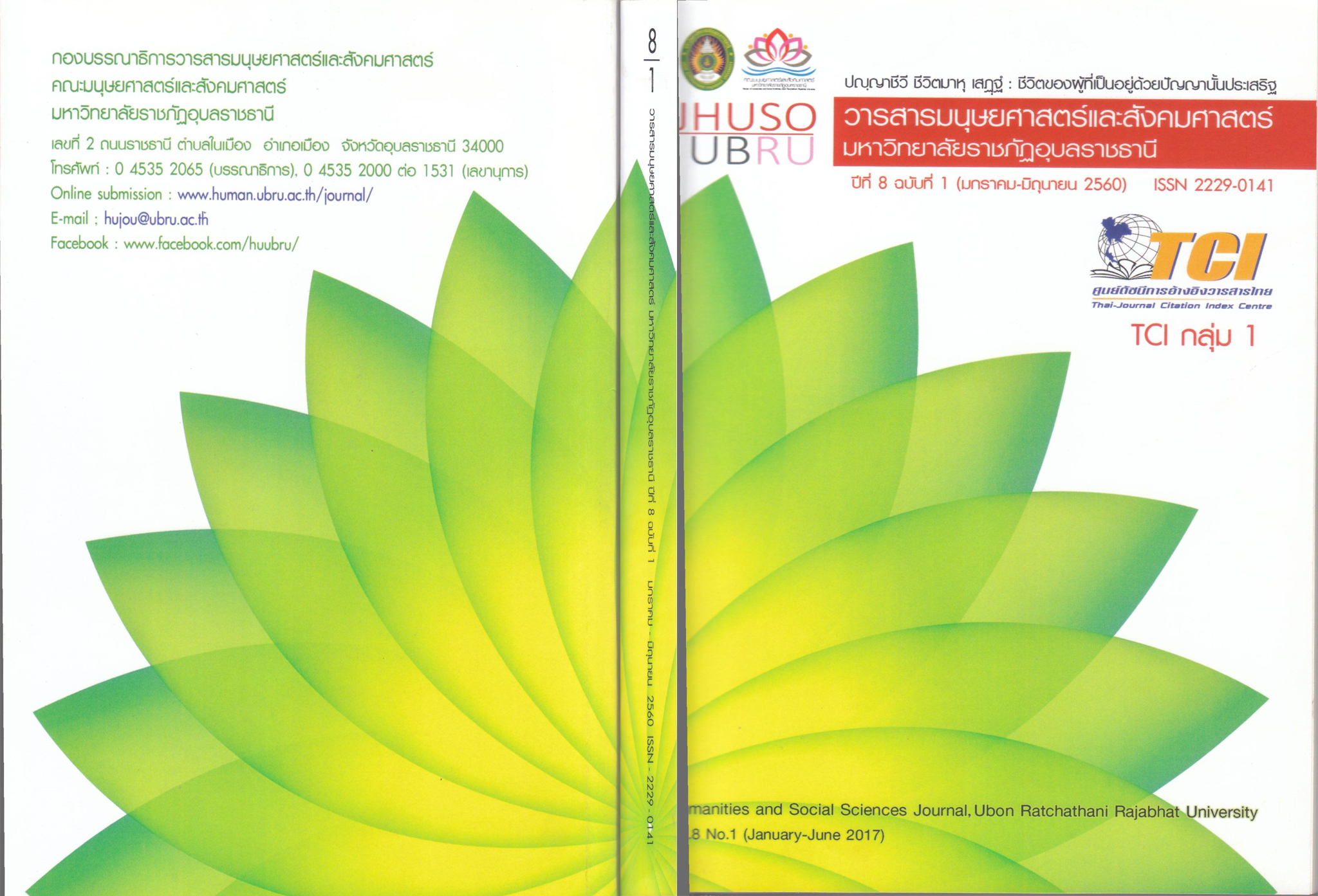พฤติกรรมการท่องเที่ยวของท่องเที่ยวเชิงกีฬา จังหวัดบุรีรัมย์
Main Article Content
บทคัดย่อ
งานวิจัยน้ีมีวัตถุประสงค์เพ่ือศึกษาพฤติกรรมการท่องเท่ียวของนักท่องเท่ียวเชิงกีฬา จังหวัดบุรีรัมย์ เพื่อทราบเป็นแนวทางการพัฒนาการท่องเที่ยวจังหวัดบุรีรัมย์ ให้เหมาะสม กับกลุ่มนักท่องเท่ียวเชิงกีฬา โดยการศึกษาคร้ังน้ีอาศัยแบบสอบถามเป็นเคร่ืองมือในการเก็บ รวบรวมข้อมูล ซ่ึงกลุ่มตัวอย่างคือนักท่องเท่ียวเชิงกีฬาชาวไทยท่ีเดินทางมาท่องเท่ียวจังหวัด บรุรีมัย์ จ�านวน 400 คน และวเิคราะหข์อ้มลูดว้ยโปรแกรมการวเิคราะหข์อ้มลูทางสถติสิ�าเรจ็รปู โดยใชส้ถติเิชงิพรรณนา และใชส้ถติเิชงิอนมุานในการทดสอบสมมตฐิาน เพอื่ท�าการเปรยีบเทยีบ ระดับความแตกต่างเป็นรายคู่ ผลการศึกษาพบว่านักท่องเที่ยวส่วนใหญ่เป็นเพศหญิง อายุ 24 ปี จัดอยู่ในกลุ่ม
Generation-Y (อายุ 15-35 ปี) มีสถานภาพโสดจบการศึกษาในระดับปริญญาตรี ประกอบ อาชีพพนักงานเอกชน และมีรายได้เฉลี่ยอยู่ที่ 15,000 บาทต่อเดือน ในด้านพฤติกรรม การทอ่งเที่ยวของนกัท่องเทยี่วเชิงกีฬาสว่นใหญ่ พบว่า สอื่ทใี่ช้เพอื่การรบัร้กู่อนการเดนิทางคอื สื่อสังคมออนไลน์ (เช่น Facebook, Instragram, Youtube ฯลฯ) มีจุดประสงค์การท่องเที่ยว เพ่ือชมการแข่งขันกีฬา โดยมีผู้ร่วมเดินทาง (รวมผู้ตอบแบบสอบถาม) จ�านวน 2 คน ใช้รถ ส่วนบุคคล (รถยนต์/จักรยานยนต์) เพ่ือการเดินทาง ซ่ึงนักท่องเท่ียวส่วนใหญ่ท�าการค้างแรม ในท่ีพักราคาประมาณ 1,000 บาท มีระยะเวลาการท่องเท่ียว 2 วัน ค่าใช้จ่ายเฉล่ียในการ ท่องเที่ยวแต่ละครั้งอยู่ที่ 10,000 บาท และมีความถี่ในการท่องเที่ยวอยู่ที่ 2 ครั้งต่อปี
Article Details
เอกสารอ้างอิง
Chansawang, R. (2002). Sports Tourism. Nonthaburi: Sukhothai Thammathirat Open University Press. Choibamroong, T. (2011). The role of local government organizations and sustainable tourism development on the basis of sufficiency economy. Bangkok: The Cabinet Publishing House and the Government Gazette.
Choibamroong, T. (2012). The network of Tourist partners in Master Degree. Bangkok: SPC. Development and management of spatial tourism.
Delpy, Neirotti L. (2003). Sport and Adventure Tourism. New York: The Howorth Hospitality Press.
Department of Tourism and Leisure Management Lancashire Business School. (2003). Sport Tourism: The case for a Local Approach in Africa. Tanzania: University of Central Lancashire.
Frank Small & Associates Co., Ltd. (1994). Final Report Sport tourism in Thailand. Bangkok: Frank Small and Associates.
Gammon, S and Robinson, T. (1997). Sport Tourism: A Conceptual Framework. The Journal of sport tourism, 4(3), 8-24.
Gibson, H. (1998). Sport Tourism: a Critical Analysis of Research. The Sport Management Review, 1(1), 45-76.
Hall, CM. (1992). Adventure, Sport and Health Tourism. London: In Special Interest Tourism.
Jira-On, P. (2004). The Factors Influencing on the selection of hotel services in Amphoe Muang. Buriram province. (Master of Business Administration Business Administration, Mahasarakham University).
Jirasanyanasakul, P. (2011). Study on Sporting Behavior in Chonburi Province. Department of Tourism, Faculty of Liberal Arts. Eastern Rajamangala
University of Technology.
Kamlangngarm, S. and others. (2007). The study of consumption behavior of tourism products in the arts, culture and traditions of tourists in the Northeastern provinces. The Sustainable Tourism Development and
Management Information Bank Project, Northeastern provinces, The Thailand Research Fund.
Kanchanakit, Sombat. (2011). Sport Tourism and Sport Industry in Thailand: Consumer Behavior. Bangkok: Chulalongkorn University.
Liu Boli and others. (2003). Type and Characteristics of Demand in Sports Tourism Market. China: Chengdu Sports Unversity.
McIntosh,Robert W.and Goelner, Charles R. (1986). Tourism: Principles, Practices, Philosophies. 7 th. New York: John&Sons.Printed in the United of American.
Ministry of Tourism and Sports. (2011). National Tourism Development Plan 2012-2015. Bangkok: Ministry of Tourism and Sports.
Prachanant, P and others. (2007). Consumption behavior of tourist products of the Northeastern Isan tourists. The Sustainable Tourism Development and Management Information Bank Project, Northeastern provinces, The Thailand Research Fund.
Ruskin, H. Selected Views on Socio-economic Aspects of Outdoor Recreation, Outdoor Education and Sport Tourism. (1987). Proceedings of the
International Seminar and Workshop on Outdoor Education, Recreation and Sport Tourism Garmise M (ed.). Natanya. Israel: Emmanuel Gill Publishing.
Serirattana, S. (1996). The Complete guide book of consumer behavior. Bangkok: Wisit Pattana
Silpajaru, T. (2007). Research and data analysis with SPSS. (7th ed.). Bangkok: V Inter Print.
Standeven, J & De Knop, P. (1999). Sport Tourism. Champaign, IL: Human Kinetics.
Stephen, D. R. (2001). Developing Sport Tourism. Urbana-Champaign: National Laboratory for Tourism and eCommerce University of Illinois.
Suthuvanakul, P and Kitiwong, W. (2009). The Validity of Research Tools. Chiang Mai: Faculty of Education Chiang Mai University.
Tassiopoulos and Haydam. (2007). Golf Tourists in South Africa: A Demand-side Study of a Niche Market in Sport Tourism. The Tourism Management, 29(5), 870-882.
Thairath Economic Team. (2014). Buriram Modeling prototype of a new city. Thairath, 14 July 2014, 8.
The Chamber of Commerce of Thailand. (2014). A summary of keynote speech by Mr. Kobkarn Wattanawaranggoon, Minister of Tourism and Sports. Retrieved on 6 January 2015, from https://www.thaichamber.org/scripts/ detail.asp?nNEWSID=13672
Weed, M. and Bull, C. (1997). Influences on Sport-Tourism Relations in Britain: The effects of Government Policy. London: Tourism and Recreation research.
Wittawat-Oran, S. (2012). Gen Y : well trained for the well work. Bangkok: National Multimedia Group Public Company Limited.


